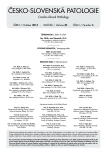Fluorescence in situ hybridization on histologic sections
Authors:
Marcela Mrhalová; Roman Kodet
Authors‘ workplace:
Ústav patologie a molekulární medicíny 2. LF UK a FN v Motole, Praha
Published in:
Čes.-slov. Patol., 49, 2013, No. 4, p. 114-122
Category:
Review articles
Overview
I-FISH (fluorescence in situ hybridization on interphasic nuclei) represents a laboratory method linking morphological investigations (histological sections of formaldehyde fixed and paraffin embedded tissues) with molecular techniques (sequence specificity of nucleic acids bases for a certain locus). I-FISH is relatively undemanding for a laboratory workout, but offering a lot of important information about the investigated cells. Within a scope of pathology departments I-FISH is utilized mostly in diagnostics of neoplasms. I-FISH is helpful in detecting gene copy numbers (amplifications or deletions), and, importantly, in establishing copy numbers of individual chromosomes (polysomies or monosomies), chromosomal breaks and translocations. At present, I-FISH is used not only for diagnosis and estimation of prognosis, but also as a method to qualify a patient for a targeted biological therapy. Because demands on investigation of solid tumors keep raising I-FISH becomes a part of routine investigations. The aim of this paper is to summarize principles and the utility of I-FISH and to help the interested readers in finding a basic orientation in this laboratory method.
Keywords:
fluorescence in situ hybridization – histological section – fluorescence microscope – probe – interphasic nuclei – formaldehyde fixation
Sources
1. Gall JG, Pardue ML. Formation and detection of RNA-DNA hybrid molecules in cytological preparations. Proc Natl Acad Sci U S A 1969; 63(2): 378-383.
2. Pardue ML, Gall JG. Molecular hybridization of radioactive DNA to the DNA of cytological preparations. Proc Natl Acad Sci U S A 1969; 64(2): 600-604.
3. Rudkin GT, Stollar BD. High resolution detection of DNA-RNA hybrids in situ by indirect immunofluorescence. Nature 1977; 265(5593): 472-473.
4. Rost FWD. Fluorescence microscopy. Press Syndicate of the University of Cambridge, Cambridge University Press: Cambridge, New York, USA; 1996.
5. Olympus. Microscopy resource center, Olympus America Inc. 2012, Available from: http://www. olympusmicro.com/
6. Mrhalová M, Kodet R. Paget’s disease of the nipple: a copy number of the genes ERBB2 and CCND1 versus expression of the proteins ERBB-2 and cyclin D1. Neoplasma 2003; 50(6): 396-402.
7. Mrhalová M, Kodet R, Strnad P. Invazivní duktální karcinomy mléčné žlázy: vyšetření počtu kopií genu CCND1 a počtu chromozómů 11 metodou fluorescenční in situ hybridizace (FISH) v porovnání s expresí proteinu cyklín D1 a receptoru pro estrogen (ER alpha) detegovanou imunohistochemicky (IHC). Cas Lek Cesk 2002; 141(22): 708-714.
8. Mrhalová M, Plzák J, Betka J, Kodet R. Epidermal growth factor receptor - its expression and copy numbers of EGFR gene in patients with head and neck squamous cell carcinomas. Neoplasma 2005; 52(4): 338-343.
9. Mrhalová M, Kodet R, Strnad P. Korelace exprese c-erbB-2 genu (detekce metodou FISH) s membránovou expresí erbB-2 proteinu (detekce metodou IHC) u pacientek s karcinomy mléčné žlázy. Cas Lek Cesk 2001; 140(18): 553-559.
10. Mrhalová M, Kodet R. Indikace k léčbě nemocných s invazivními duktálními karcinomy mléčné žlázy Herceptinem z pohledu laboratorní diagnostiky - vyšetření ERBB-2 proteinu a stanovení počtu kopií ERBB2 genu. Přehled problematiky. Cesk Patol 2002; 38 Suppl 1: 4-14.
11. Mrhalová M, Kodet R. A modified approach for I-FISH evaluation of ERBB2 (HER-2) gene copy numbers in breast carcinomas: comparison with HER-2/CEP17 ratio system. J Cancer Res Clin Oncol 2007; 133(5): 321-329.
12. Eckschlager T, McClain K. Comparison of fluorescent in situ hybridization (FISH) and the polymerase chain reaction (PCR) for detection of residual neuroblastoma cells. Neoplasma 1996; 43(5): 301-303.
13. Procházka P, Hraběta J, Vícha A, Eckschlager T. Expulsion of amplified MYCN from homogenously staining chromosomal regions in neuroblastoma cell lines after cultivation with cisplatin, doxorubicin, hydroxyurea, and vincristine. Cancer Genet Cytogenet 2010; 196(1): 96-104.
14. Mrhalová M, Kodet R, Kalinová M, Hilská I. Relative quantification of ERBB2 mRNA in invasive duct carcinoma of the breast: correlation with ERBB-2 protein expression and ERBB2 gene copy number. Pathol Res Pract 2003; 199(7): 453-461.
15. Kodet R, Mrhalová M, Krsková L, et al. Mantle cell lymphoma: improved diagnostics using a combined approach of immunohistochemistry and identification of t(11;14)(q13;q32) by polymerase chain reaction and fluorescence in situ hybridization. Virchows Arch 2003; 442(6): 538-547.
16. Mrhalová M, Krsková L, Kalinová M, Soukup J, Kodet R. Folikulární lymfomy: molekulární diagnostika t(14;18)(q32;q21) - fluorescenční in situ hybridizace, kvalitativní a kvantitativní PCR Cesk Patol 2003; 39(3): 130-137.
17. Soukup J, Krsková L, Mrhalová M, et al. Velkobuněčné difúzní B-lymfomy: heterogenní původ a prognóza z hlediska současné diagnostiky. Cas Lek Cesk 2003; 142(7): 417-422.
18. Kobayashi T, Tsutsumi Y, Sakamoto N, et al. Double-hit lymphomas constitute a highly aggressive subgroup in diffuse large B-cell lymphomas in the era of Rituximab. Jpn J Clin Oncol 2012; 42(11): 1035-1042.
19. Kodet R, Mrhalová M, Krsková L, Stejskalová E. Anaplastický velkobuněčný lymfom: přehled problematiky Cesk Patol 2003; 39(3): 102-114.
20. Kodet R, Mrhalová M, Stejskalová E, Kabíčková E. Burkitt lymphoma (BL): reclassification of 39 lymphomas diagnosed as BL or Burkitt-like lymphoma in the past based on immunohistochemistry and fluorescence in situ hybridization. Cesk Patol 2011; 47(3): 106-114.
21. Stejskalová E, Jarošová M, Kabíčková E, et al. Primary mediastinal (thymic) large B-cell lymphoma with a der(14)t(8;14)(q24;q32) and a translocation of MYC to the derivative chromosome 14 with a deleted IgH locus. Cancer Genet Cytogenet 2006; 170(2): 158-162.
Labels
Anatomical pathology Forensic medical examiner ToxicologyArticle was published in
Czecho-Slovak Pathology

2013 Issue 4
Most read in this issue
- How to improve the histopathological diagnosis of hepatocellular benign affections (adenoma versus focal nodular hyperplasia) in daily practice?
- Immunophenotypization by means of flow cytometry in pathology
- Minimal residual disease – detection possibilities in haematological and non-haematological malignancies
- Fluorescence in situ hybridization on histologic sections
